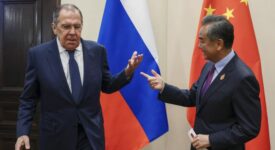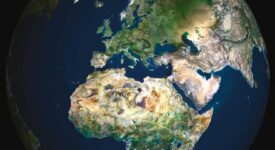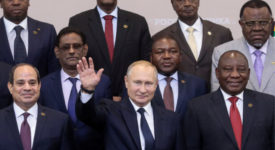Even before the war in Ukraine, the European Union had been gearing toward an “increasingly competitive strategic environment” by developing its geo-political autonomy to meet Europe’s security responsibility and reduce strategic shrinkage. Post the Ukraine invasion, however, security and defense have assumed greater relevance.
Russia continues to be a permanent adversary in the broader European estimation. However, it is China’s growing global influence that has instilled a new momentum into the EU’s pivot to the Indo-Pacific, the world’s current and future economic and political center of gravity.
THE GLOBAL GATEWAY —- In 2021, the EU solidified its strategic outreach to Asia with the release of the EU Strategy for Cooperation in the Indo-Pacific and the €300 billion Euros trade and investment-centric Global Gateway strategy. This new integrated European approach to the region began in earnest in 2018 with the release of the Indo-Pacific strategies of three of its member countries ? France, Germany, and the Netherlands in that order ? in quick succession, and the EU strategy on Connecting Europe and Asia. Notably, these strategies are non-confrontational and focus on cooperation with like-minded regional partners such as India and Japan. They keep intact the centrality of the Association of Southeast Asian Nations (ASEAN). Viewing these partnerships through the lens of strategic autonomy, creating minilateral regional groupings seems an obvious choice. In particular, given that the EU, India, and Japan are all intent on building their own unique brands and in a wider relationship with each other, establishing an EU-India-Japan trilateral, on the heels of the Italy-India-Japan grouping, could be of immense value. But what shape would this trilateral take? What are the prospects of forming such a trilateral outside an American-led or Chinese-led architecture? How critical would the EU-India-Japan trilateral be to the new global supply chains? In which areas could this trilateral cooperate in the Indian Ocean? What would be the scope of cooperation with ASEAN for this trilateral?
STRATEGIC BILATERAL AND TRILATERAL TIES —- Objectively speaking, both India and Japan are strategic partners of the EU that share a Special Strategic and Global Partnership between themselves. Such deep-seated ties provide for a global and value-oriented trustworthy and confidence-inducing grouping much coveted in international collaborations. The creation of such a trilateral would not only solidify their bilateral ties — India-Japan, India-EU, EU-Japan — but also provide a much-needed boost to wider multilateral cooperation in the region. All three powers subscribe to a multipolar world order while being dedicatedly committed to safeguardIng a free and open rules-based international order. This provides the basis for a solid foundational connection. In recent years, with Donald Trump’s “America First” foreign policy and later with the haphazard US withdrawal from Afghanistan and the signing of AUKUS that snubbed France, the transatlantic allies started losing faith in the United States as the top security provider. Since then the siren call for the EU’s strategic autonomy has only grown louder, culminating in the recently released Strategic Compass that seeks to broaden the scope of the EU as a credible global security provider.
CHINA ENTANGLEMENT —- Meanwhile, even as Brussels, Tokyo, and Delhi have sought to limit their economic dependence on China in the aftermath of the Covid-19 pandemic and growing security concerns, complete decoupling from China is an improbable proposition. Some have aptly called it “a pipe dream”. As of 2021, China remains a top trade partner for the EU, India, and Japan across sectors. Hence, while the three share a common threat perception of China as a revisionist authoritarian power, they are realistic about the importance of maintaining a balance in their approaches to Beijing, in contrast to Washington’s expectations. Thus, an India-Japan-EU trilateral would allow the three actors to build a non-US, non-China driven multipolar tripartite structure that furthers their common interests in the region while protecting national security.
ALIGNMENT OF CORE VALUES: SEEKING WIDER AMBIT —- The three pillars of Japan’s Free and Open Indo-Pacific (FOIP) and India’s Security And Growth for All in the Region (SAGAR) vision are in line with the EU’s core values and principles of democracy, rule of law, human rights, and international norms and standards. This alignment allows for cooperation in areas such as maritime security, resilient supply chains, energy, infrastructure, and digital connectivity, ocean governance, climate action, defense and security, and enhanced engagement in troubled European regions. Economically, all three powers face the urgency of a post-pandemic fiscal recovery. Here, creating sustainable and resilient supply chains has emerged as a critical area of focus. To this end, the EU could embrace the Supply Chain Resilience Initiative (SCRI) launched by Japan, India, and Australia, especially via its Global Gateway strategy, which focuses on “boosting competitiveness and global supply chains.” The SCRI can help enhance the EU’s geo-economic ambitions in the “highly interconnected” Indo-Pacific, furthering its agenda of strategic autonomy. Similarly, the India-Japan-EU trilateral can offer connectivity alternatives, such as in Asia and the EU’s extended neighborhood, where China’s Belt and Road Initiative (BRI) has made significant inroads. Opportunities in areas such as transport, digital, energy, pharmaceuticals, renewables, and infrastructure can be created through already existing cooperation frameworks. Among them: the EU-Japan Partnership on Sustainable Connectivity and Quality Infrastructure, Global Gateway, Japan’s Expanded Partnership for Quality Infrastructure (EPQI), India’s Act East Policy, Japan’s Western Balkans Cooperation Initiative, and India’s Look West policy.
EMBRACING TAIWAN, ASEAN: With regard to the Taiwan question too, the Ukraine invasion has sensitized Europe to the potential occupation of Taiwan and the existential threat for extended neighbors such as India and Japan. Both neighbors have stepped up their engagement with Taiwan and are indicating the possibility of further change, should the threat from China increase substantially. The trilateral could help build a global consensus on Taiwan. For example, liaising with the Quadrilateral Security Dialogue (Quad) that is seeking to embrace Taiwan to ease its isolation in multilateral forums where China’s clout is a deterrent. One of the most important binding domains is the trio’s unambiguous emphasis on the ASEAN centrality principle. The EU’s integrated approach can draw from India’s and Japan’s long standing cooperation with ASEAN states and can help build tailored partnerships in Southeast Asia, not just as a trade partner but also as a credible security provider. The trilateral connection will ease the outreach to these states with their diverse national interests, and identify common areas where geo-political or strategic support is required. Some of the focus areas include climate action, ocean governance, digital connectivity, and infrastructure development. As ASEAN dialogue partners, they could also work toward improving humanitarian access. In places such as Myanmar, they could also help initiate a political pathway to restore democracy. The presence of India and Japan would help in enhancing the EU’s credibility too.
BEYOND ASIA: VISION FOR AFRICA AND MARITIME SECURITY —- Beyond Asia, in Africa the trilateral can find convergence in mutually beneficial areas. The EU could help reinvigorate the Platform for Japan-India Business Cooperation in Asia-Africa Region. It could also involve India and Japan, as long standing contributors in the continent, to help implement the EU’s joint vision for Africa as outlined at the sixth African Union-EU summit in February 2022. An Africa-Europe Investment Package of €150 billion Euros was earmarked at the time to support a common ambition for 2030. A collective effort ? in concert with the mutually reinforceable Global Gateway and Build Back Better World ? will effectively challenge China’s growing African footprint. Another key area of synergy is maritime security. The EU, like India and Japan, wants to build an open and rules-based regional security order while protecting sea lines of communication (SLOCs). But importantly, the EU also wants to promote capacity building and upgrade its maritime presence via EU member-states. To achieve this, the EU will look to lead more joint exercises and port calls with Indo-Pacific partners, accentuating existing efforts to build democratic maritime deterrence in the region.
MINILATERAL STRENGTH —- The trilateral can also provide a basis to strengthen the EU’s exchanges with India and Japan on security, defense, technology, and trade. An important area is counter-piracy operations. India and Japan are already partners in the EU’s capacity-building initiative Critical Maritime Routes in the Indian Ocean (CRIMARIO) project. The trilateral could build on this partnership through the recently implemented Coordinated Maritime Presences (CMP) in the North-Western Indian Ocean. The EU’s focus on the Indian Ocean as a gateway to the Indo-Pacific highlights Brussels’ attempts to protect geo-economic interests, creating room for such a trilateral connection. In brief, amidst growing polarization in world politics due to the US-China hegemonic great power rivalry, the middle and regional powers in the Indo-Pacific are increasingly moving toward minilateral formations. India and Japan are already part of several such groupings, together through the Quad, and separately through such as India-Russia-China, Japan-US-EU. Nevertheless, a comprehensive integrated partnership of the two with the EU, which runs parallel to, if not beyond the US or China-led mechanisms, will help create a mutually beneficial arrangement that could act as a stabilizing power in the region.
‘In Search of an EU-India-Japan Trilateral’ — Op-Ed by Jagannath Panda — Italian Institute for International Political Studies / ISPI.
(The Op-Ed can be downloaded here:
https://www.isdp.eu/publication/in-search-of-an-eu-india-japan-trilateral/)







